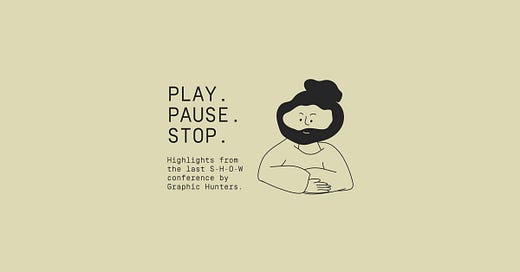What’s your job title?
Data analyst? Journalist? Researcher? Designer? Teacher? None of the above?
If we were to be exhaustive, the list would be very, very long. That’s because there is no short and smooth path to data visualisation. We all come from different backgrounds and bring different skills to the field. Which is both fascinating and frightening at the same time. To navigate this, we have to constantly look for balance. A balance between work and rest. Between learning and doing. Between pushing boundaries and compromising. Or, in other words, we oscillate between three states: play, pause, and stop.
Play. Pause. Stop.
That was the theme of the latest (and, sadly, the last) S-H-O-W event which took place in Utrecht last week. If you were at the conference, you’re probably still buzzing from all the learning and connections. It’s almost hard to believe that a 2-day event can inspire so much awe.
If you were not in Utrecht or missed the second day that happened fully offline, I’ve got good news for you! While the recordings will only be made available to the participants, I’ll share some of the event highlights in this edition of The Plot. Let’s start with two topics that stuck with me and then move on to a list of (new) people for you to follow.

The ideas
Two major topics kept surfacing during the event: creativity and impact. Both of these concepts can have a terrifying vibe to them. We often see creativity as unattainable for mere mortals and equate it to designing complex visuals which require advanced graphic skills and thousands of lines of code. Similarly, we tend to approach the notion of impact in its largest possible sense: if we don’t solve world poverty or climate change, then we’ve failed.
Thinking this way doesn’t really help us on a daily basis. So let’s bring it down a notch. How do you produce playful and unique work, while also ensuring that it has a positive impact? Not for the entire world in one single go, but for yourself and the people around you to begin with.
I loved how Nadieh Bremer untangled creativity in pragmatic terms. She had two tips for us: first, just start, then iterate (a lot). You just need to start may sound like an obvious and simplistic piece of advice. But no amount of planning or contemplating beats actual doing. When you start a new project, take a piece of paper and begin sketching ideas. During this process, try not to think in chart types. Instead, ask yourself: what is it that I’m trying to highlight? What shapes would represent that data best? How many different versions of it can I imagine? It’s highly likely that you’ll end up with a familiar graph type, but trying out different options will help you add a unique touch to it.
There, you’ve just done something creative. That wasn’t too scary, was it?
Then, when you move away from play and into pause, the question of impact arises. Manuel Lima closed the first day of the conference by encouraging us to design for a better world. But what does that mean exactly? How can you make sure your work has a positive impact? That it matters?
Perhaps you’re lucky to work for a company whose mission is all-out impact driven. But not all of us have that luxury, or at least not 100% of the time. So how do you find meaning in those moments? One of the first things to consider is whether you’re thinking of the humans behind the data you’re designing with. How would they feel if they were looking at your work? Would they feel respected? If the answer is no, how can you do better?
It may sound small, but start there, and see how it goes. 💛 Most importantly, don’t be too hard on yourself: designing with humans in mind is perhaps impactful enough for now.
The people
Some of the people on the programme of the conference were very well known—I’m sure you’ve already heard of Nadieh Bremer and Manuel Lima many times. While it’s always great to learn from long-standing experts in the field, I was even more delighted to discover designers, researchers, and studios I hadn’t encountered previously. So here are my top five for you to dig into next time you want to pause and get inspired:
Happy exploring!
See you next week,
—Evelina



